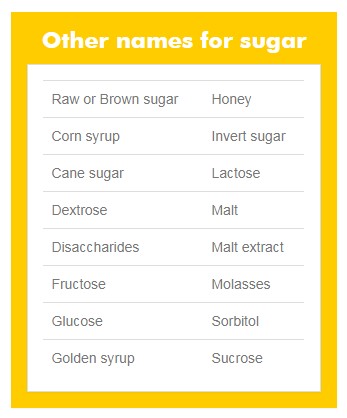
Sugar has certainly become a popular topic. Surprisingly, most of the sugar we drink and eat is 'hidden' – so we don't always know we're consuming it.
In terms of health risks, we only need to be concerned about ‘added sugar’. That is, sugar that has been added to food or drink.
Plain dairy foods and fruit naturally contain some sugar, but it’s not added. These are nutritious foods which should be included in a healthy diet.
Uncover the sugar in the food and drinks you consume with these tips and tricks:
Food labels are your 'added sugar' friend
Identifying the ‘added sugar’ in products can be tricky, but reading food labels is a good starting point.
Firstly, check the ingredients list for sugar. But beware – there are over 40 different names for sugar and some foods can contain different types. Here are some of the common names for sugar to look out for on food labels:

If you see more than one of these names in an ingredients list, see them more than once, or see one of them in the first 4 ingredients, the food is likely to be high in added sugar.
Hot tip: The World Health Organization recommends we limit our added sugar intake to 24 grams of sugar or six teaspoons a day. Recognising 4 grams of sugar as approximately one teaspoon is a good way of keeping an eye on how much sugar we are taking in when checking labels.
Avoid the red
Next, look at the nutrition information panel. Added sugar usually isn’t labelled, but you can try to work it out from the total sugar amount.
Any foods with more than 15g sugar per 100g are definitely high in added sugar and should be limited. The best choices are foods with less than 5g sugar per 100g.

It’s trickier when foods contain milk or fruit as well as added sugars.
As a rule of thumb, about 5–6% of the sugar in yoghurt and milk is lactose (sugar in milk) and is naturally occurring, so anything above that is added. Every 100g of plain milk or yoghurt should have around 6 grams of lactose so if it’s higher than this its likely sugar has been added. For fruit-based dishes, check the ingredients list for signs of added sugar.
If you don’t have time to read food labels and want to cut back on added sugar, there are also lots of delicious foods you can choose that don’t contain added sugar. Try to eat more nuts, plain yoghurt (add your own toppings or make it fresh), fruit, vegetables (including raw vegetables as a snack), cheese and eggs.
Another easy way to cut back on added sugar in your diet is to avoid sugary drinks. Sugary drinks of any kind don’t belong in a healthy diet so it’s the perfect place to start. Try our delicious fruity waters for a refreshing change.
To find out more ways you can avoid sugary drinks check out www.cancervic.org.au/healthyweight